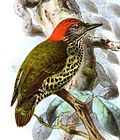Dendropicos
| Dendropicos | |
|---|---|

| |
| Cardinal woodpecker (Dendropicos fuscescens) | |
| Scientific classification | |
| Domain: | Eukaryota |
| Kingdom: | Animalia |
| Phylum: | Chordata |
| Class: | Aves |
| Order: | Piciformes |
| Family: | Picidae |
| Tribe: | Melanerpini |
| Genus: | Dendropicos Malherbe, 1849 |
| Type species | |
| Dendropicos lafresnayi (cardinal woodpecker) Malherbe, 1849
| |
| Species | |
|
see text | |
Dendropicos is a genus of woodpeckers in the family Picidae. They are small woodpeckers that are native to the sub-Saharan woodlands and forests.[1]
Taxonomy
The genus Dendropicos was introduced by the French ornithologist, Alfred Malherbe in 1849.[2] The type species was subsequently designated as one of the subspecies of the cardinal woodpecker.[3][4] The word Dendropicos comes from the Greek dendron meaning tree and pikos for woodpecker.[5] Molecular genetic studies have shown that the genus Dendropicos is sister to the genus Chloropicus.[6]
The genus Dendropicos formerly contained several additional species. A 2015 molecular phylogenetic study that analysed nuclear and mitochondrial DNA sequences from pied woodpeckers found that Dendropicos was polyphyletic. In the rearranged genera the bearded, fire-bellied and yellow breasted woodpeckers were moved to Chloropicus while the Arabian woodpecker was moved to Dendrocoptes.[7][8] The taxonomic committee of the British Ornithologists' Union have recommended an alternative arrangement of species in which the genera Dendrocoptes and Leiopicus are combined into a larger Dendropicos.[9]
Elliot's, African grey, eastern grey and olive woodpeckers are sometimes placed in a separate genus, Mesopicos.[1]
The genus contains the following 12 species:[8]
| Image | Common Name | Scientific name | Distribution |
|---|---|---|---|
| Little grey woodpecker | Dendropicos elachus | Cameroon, Chad, Gambia, Mali, Mauritania, Niger, Nigeria, Senegal, and Sudan | |
 |
Speckle-breasted woodpecker | Dendropicos poecilolaemus | Cameroon, Central African Republic, Chad, Democratic Republic of the Congo, Kenya, Nigeria, Rwanda, South Sudan, and Uganda. |
 |
Abyssinian woodpecker | Dendropicos abyssinicus | Eritrea and Ethiopia |
 |
Cardinal woodpecker | Dendropicos fuscescens | Angola, Benin, Botswana, Burkina Faso, Burundi, Cameroon, Central African Republic, Chad, Congo, Democratic Republic of Congo, Djibouti, Eritrea, Ethiopia, Gabon, Gambia, Ghana, Guinea, Guinea-Bissau, Ivory Coast, Kenya, Lesotho, Malawi, Mali, Mauritania, Mozambique, Namibia, Nigeria, Rwanda, Senegal, Sierra Leone, Somalia, South Africa, South Sudan, Sudan, Swaziland, Tanzania, Togo, Uganda, Zambia and Zimbabwe |
 |
Gabon woodpecker | Dendropicos gabonensis | Southern Nigeria to south-western Cameroon |
 |
Melancholy woodpecker | Dendropicos lugubris | Cameroon, Ivory Coast, Ghana, Guinea, Guinea-Bissau, Liberia, Nigeria, Sierra Leone and Togo |
 |
Stierling's woodpecker | Dendropicos stierlingi | southern Tanzania, southwestern Malawi and northern Mozambique |
| Elliot's woodpecker | Dendropicos elliotii | Angola, Cameroon, Central African Republic, Republic of the Congo, Democratic Republic of the Congo, Equatorial Guinea, Gabon, Nigeria, Rwanda, and Uganda | |
 |
African grey woodpecker | Dendropicos goertae | Angola, Benin, Burkina Faso, Burundi, Cameroon, Central African Republic, Chad, Congo, Democratic Republic of Congo, Equatorial Guinea, Eritrea, Ethiopia, Gabon, Gambia, Ghana, Guinea, Guinea-Bissau, Ivory Coast, Kenya, Liberia, Mali, Mauritania, Niger, Nigeria, Rwanda, Senegal, Sierra Leone, South Sudan, Sudan, Tanzania, Togo and Uganda |
 |
Eastern grey woodpecker | Dendropicos spodocephalus | Ethiopia, Kenya, South Sudan, Sudan and Tanzania |
 |
Olive woodpecker | Dendropicos griseocephalus | Angola, Burundi, Democratic Republic of the Congo, Malawi, Mozambique, Namibia, Rwanda, South Africa, Swaziland, Tanzania, Uganda, Zambia, and Zimbabwe |
 |
Brown-backed woodpecker | Dendropicos obsoletus | Benin, Burkina Faso, Cameroon, Central African Republic, Chad, Democratic Republic of the Congo, Eritrea, Ethiopia, Gambia, Ghana, Guinea, Guinea-Bissau, Ivory Coast, Kenya, Mali, Mauritania, Niger, Nigeria, Senegal, Sierra Leone, Sudan, Tanzania, Togo, and Uganda |
Description
Only males have red plumage in the crown, and some species have red plumage on the rump or belly in either sex.[1]
References
- ^ a b c Gorman, Gerard (2014). Woodpeckers of the World: The Complete Guide (Helm Photographic Guides). London: Bloomsbury. p. 165. ISBN 978-1408147153.
- ^ Malherbe, Alfred (1849). "Nouvelle classification des picinée ou pics". Mémoires de l'Académie nationale de Metz (in French). 30: 316, 338.
- ^ Sclater, William Lutley (1921). "Genus Dendropicos". Bulletin of the British Ornithologists' Club. 42: 25.
- ^ Dickinson, E.C.; Remsen, J.V., Jr., eds. (2013). The Howard & Moore Complete Checklist of the Birds of the World. Vol. 1: Non-passerines (4th ed.). Eastbourne, UK: Aves Press. p. 312. ISBN 978-0-9568611-0-8.
{{cite book}}: CS1 maint: multiple names: editors list (link) - ^ Jobling, James A. (2010). The Helm Dictionary of Scientific Bird Names. London: Christopher Helm. p. 133. ISBN 978-1-4081-2501-4.
- ^ Shakya, S.B.; Fuchs, J.; Pons, J.-M.; Sheldon, F.H. (2017). "Tapping the woodpecker tree for evolutionary insight". Molecular Phylogenetics and Evolution. 116: 182–191. doi:10.1016/j.ympev.2017.09.005. PMID 28890006.
- ^ Fuchs, J.; Pons, J.M. (2015). "A new classification of the pied woodpeckers assemblage (Dendropicini, Picidae) based on a comprehensive multi-locus phylogeny". Molecular Phylogenetics and Evolution. 88: 28–37. doi:10.1016/j.ympev.2015.03.016. PMID 25818851.
- ^ a b Gill, Frank; Donsker, David (eds.). "Woodpeckers". World Bird List Version 6.2. International Ornithologists' Union. Retrieved 5 May 2016.
- ^ Sangster, G.; et al. (2016). "Taxonomic recommendations for Western Palearctic birds: 11th report". Ibis. 158 (1): 206–212. doi:10.1111/ibi.12322.

